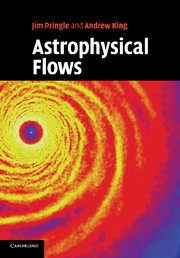Book contents
- Frontmatter
- Contents
- Preface
- 1 The basic fluid equations
- 2 Compressible media
- 3 Spherically symmetric flows
- 4 Stellar models and stellar oscillations
- 5 Stellar oscillations – waves in stratified media
- 6 Damping and excitation of stellar oscillations
- 7 Magnetic instability in a static atmosphere
- 8 Thermal instabilities
- 9 Gravitational instability
- 10 Linear shear flows
- 11 Rotating flows
- 12 Circular shear flow
- 13 Modes in rotating stars
- 14 Cylindrical shear flow-non-axisymmetric instability
- References
- Index
2 - Compressible media
Published online by Cambridge University Press: 05 June 2012
- Frontmatter
- Contents
- Preface
- 1 The basic fluid equations
- 2 Compressible media
- 3 Spherically symmetric flows
- 4 Stellar models and stellar oscillations
- 5 Stellar oscillations – waves in stratified media
- 6 Damping and excitation of stellar oscillations
- 7 Magnetic instability in a static atmosphere
- 8 Thermal instabilities
- 9 Gravitational instability
- 10 Linear shear flows
- 11 Rotating flows
- 12 Circular shear flow
- 13 Modes in rotating stars
- 14 Cylindrical shear flow-non-axisymmetric instability
- References
- Index
Summary
In Chapter 1 we emphasized that one of the major differences between astrophysical flows and the typical flows encountered in the terrestrial or laboratory context is that astrophysical fluids are compressible. This means that pressure information takes a finite time to propagate through the fluid. Because this time is often comparable to flow timescales, this gives compressible flows a fundamentally different character. In such flows the sound speed plays a role similar in some respects to that of the speed of light in the theory of relativity. In particular, sound travel times express physical causality. Pressure changes cannot propagate upstream in a supersonic flow. Subtle differences from the causal structure of relativity arise because, unlike the speed of light, the sound speed is variable and depends on the local properties of the fluid.
It is important to remember that all flows are compressible at some level. While the incompressible approximation is extremely useful in studying most terrestrial flows, intuition based on it is often a misleading guide in the astrophysical context. Moreover the elaborate mathematical apparatus assembled to study incompressible flows has limited applicability to astrophysical flows. For example, in incompressible fluids the pressure is formally disconnected from the other fluid variables, and appears only in the equation of motion, and only through its gradient (this is a mathematical expression of the assumption that it can adjust instantaneously at each point).
- Type
- Chapter
- Information
- Astrophysical Flows , pp. 17 - 43Publisher: Cambridge University PressPrint publication year: 2007



